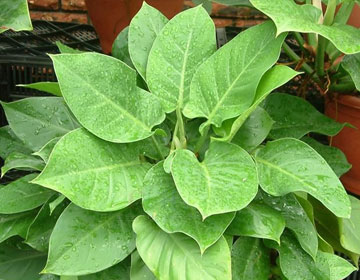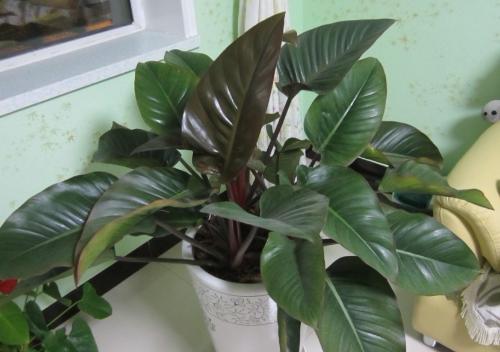How to grow and care for Philodendron
Written by Maggie
Sep 09 2021

Philodendron has about 275 species worldwide and is widely distributed in tropical America. It is now widely cultivated by flower lovers. How to grow and care for Philodendron? Let's look down together.
Philodendron info
| Botanical Name | Philodendron |
| Common Names | Philodendron |
| Plant Type | Perennial |
| Sun | Partial |
| Hardiness Zones | 9–11 (USDA) |
| Flower color | None |
| Native Area | Central America, South America |
| Mature size | 1–20 ft. tall, 1–6 ft. wide (varies by species) |
Temperature care for growing Philodendron
When we grow and care for Philodendron, the minimum temperature can not be less than 10℃, the annual optimal temperature is 20 to 30℃.
Humidity care for growing Philodendron
The relative humidity of air in spring, summer and autumn is more suitable in northern China. However, in winter in northern China, the air humidity is very low during indoor heating. When we grow and care for Philodendron, we should try to increase the air humidity around plants. If you don't have a humidifier, spray your plant leaves with water at least one or two times a day, or slightly lower the temperature. This can increase relative humidity, because cold air holds more water vapor than warm air, and old leaves won't dry out as quickly.
Light care for growing Philodendron
Philodendron grows along with other plants in their natural habitat, and grows in high places in the forest, enjoying sufficient scattered light conditions. Spotted varieties require better light conditions.
Watering care for growing Philodendron
Philodendron should not be placed outside with a water tap. The best way is to water it indoors with lukewarm water. When we grow and care for Philodendron, water Philodendron with stored rainwater or softened water as often as possible. Many current tap water contains minerals and other harmful substances (such as bleach) that are detrimental to the growth of plant roots and can leave a white stain on the leaves. The roots of Philodendron plants are not adapted to drastic changes in temperature and are not suitable for direct irrigation with tap water.
Fertilizer care for growing Philodendron
When we grow and care for Philodendron, apply a thin liquid fertilizer every two weeks during plant growth. It is better to spray fertilizer on the foliar surface.The winter temperature is low, the plant grows slowly, may not need to fertilize. Philodendron should not be grown in potted substrates or in soil with more calcium and hardening texture. It grows normally on standard peat soil, but the addition of pine needle soil and rotting cow dung is more beneficial to plant growth.

Philodendron - Most Common House Plant
Repotting
When we grow and care for Philodendron, containers should be well drained and repot once a year in the spring. Smaller plant species (e.g. Philodendron) can be grown in the hanging blue. Philodendron can also grow well in hydroponics.
Propagation of Philodendron
Philodendron cultivated in greenhouse can flower, but the fruit is not easy to ripen. If you want to sow and reproduce, you need to import seeds from abroad, and Philodendron seeds are relatively easy to germinate.In practical cultivation, seeding and reproduction are rarely used because cuttings are easy to survive. Each insert has 1 to 2 segments, buried flat in the sand, at 20 to 30℃ conditions, well rooted. The individual species is difficult to take root, but the air lamination reproduction, especially the base of the bald plant is more suitable. After the branches of the air are rooted, they can be cut off at the root place and planted in a pot for management. For the species with short internodes that do not produce sunflower, such as spring taro, Philodendron, etc., cutting cutting method can be adopted, that is, after removing the top, the buds are promoted, and then the new buds are used for cutting propagation.
Philodendron toxicity
Philodendron leaves and stems are excessive in calcium oxalate. This can be poisonous to each humans and animal when eaten.
Symptoms of poisoning
For each human and animal, signs and symptoms of toxicity can encompass drooling, nausea, vomiting, diarrhea, and a lack of appetite. There additionally can be swelling, pain, and blistering of the mouth and down the throat. Seek instantaneous clinical assist if you suspect poisoning.
Philodendron varieties
Some of the most frequent species of philodendron include:
Philodendron scandens: This plant is a very famous climber. It has heart-shaped leaves that are on occasion multicolored.
Philodendron erubescens: This is a full of life climber with reddish stems and leaves.
Philodendron melanochrysum: This plant is a amazing climber with dark, velvety leaves powdered in bronze.
Philodendron rojo: This is a hybrid that stays small and manageable however retains its vigor.
Philodendron bipinnatifidum: This is a giant plant with deeply lobed leaves and is from time to time known as lacy tree philodendron.

Latest Updated
- Benefits of Bugleweed - 7 Science-backed Health Benefits
- Bugleweed Dangers & Side Effects - Is It Poisonous?
- How to Plant Evergreen Trees - What You Should Know
- When to Plant Evergreens - Grow Guide for Evergreen Trees
- 12 Wonderful Evergreen Shrubs for Your Garden
- 12 Popular Evergreen Plants with Pictures for Beginners
- When And How To Prune A Lilac Bush Like a Pro
- How to Grow & Care for Lilac Vine (Hardenbergia Violacea)
- Japanese Lilac Tree (Syringa Reticulata) Care & Propagation Guide
- Shumard Oak Pros and Cons - What to Know
Popular Articles
- Winter maintenance of Antirrhinum Majus
- How to Grow Terminalia Mantaly Tree
- How to Grow and Care for Crossostephium Chinense
- How to grow Antirrhinum Majus in spring
- Peristeria Elata (Dove Orchid) Profile: Info & Care Guide
- Underwatered Snake Plant (Sansevieria Trifasciata) - Signs And How To Fix
- How to Care for Brazilian Jasmine Plant (Mandevilla Sanderi)
- How to Grow & Care for Graptopetalum Purple Delight in Summer
- Rosa Chinensis (China Rose): Plant Growing & Care Tips
- How to Care for Baby Sun Rose (Aptenia Cordifolia)